The lovely Technics SU-V8 has to be one of the most beautiful amplifiers from the golden age. As part of #TechnicsMonth, let’s take a closer look at the classic SU-V8 integrated amplifier.
Yep, it’s #TechnicsMonth at Liquid Audio and what better way to start than with the Technics SU-V8? What #TechnicsMonth is exactly, I don’t know, but I’m going to focus only on Technics for the next couple of articles.
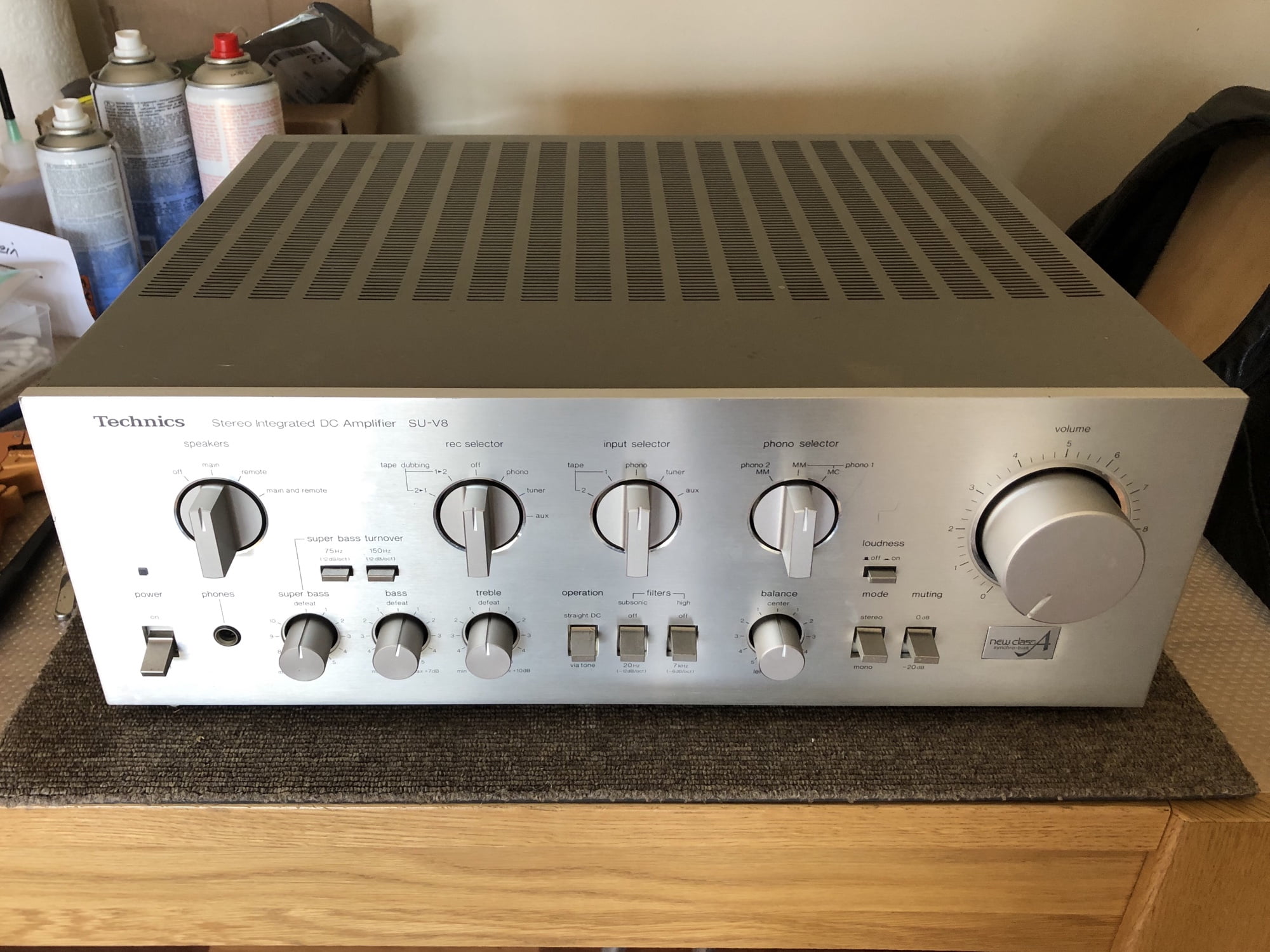
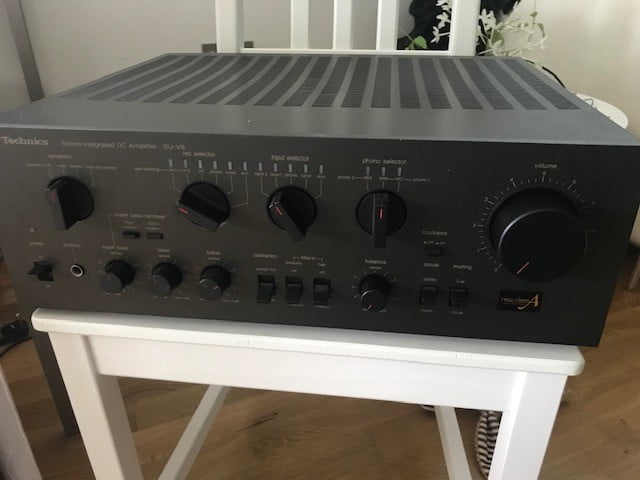
Before we go too much further, feel free to watch my accompanying video on this SU-V8 clean, repair and service:
Features
The Technics SU-V8 was the top integrated amplifier from Technics in the early ’80s. The 110-Watt-per-channel beauty featured some of the buzz-tech so typical of the time like ‘New Class A’ which isn’t class A, and ‘Super Bass’ which boosts the bass. As with most of these features, leave it turned off.
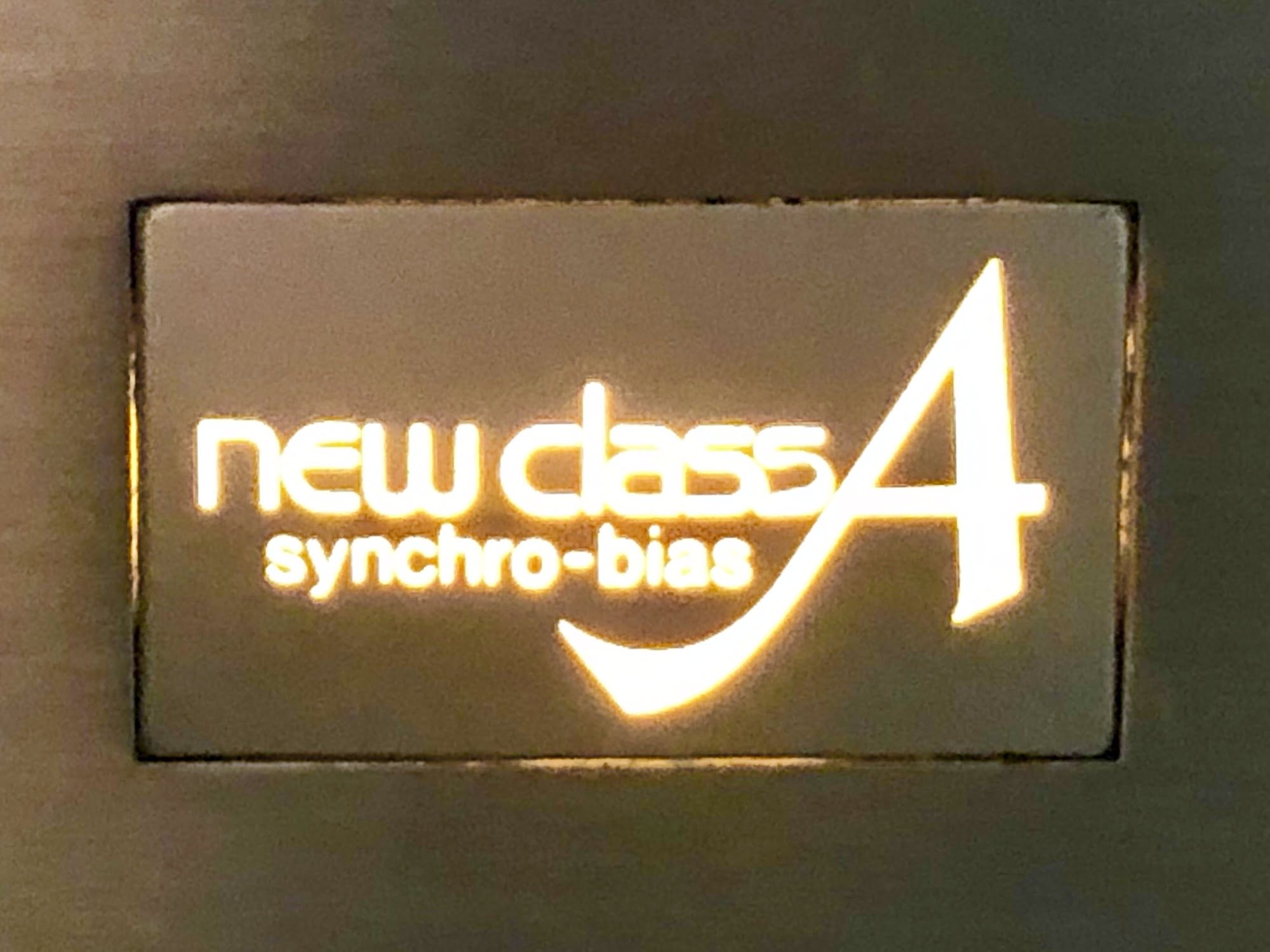
This stunning silver amplifier has gorgeous machined aluminium knobs reminiscent of Accuphase gear and every switch and control feels solid, smooth and secure. It’s also a great-sounding amp, solidly built and very serviceable. The SU-V8 is the kind of amplifier you might buy and keep for a really long time.
Anyhow, Technics was really in its stride during this era and consistently producing some of the sexiest looking and sounding hi-fi gear. Who could forget the futuristic SL-10 linear tracking turntable for example? The SU-V8 was the amp that matched the SL-10 and the other gear they sold, like the SB-8 honeycomb speakers.
You can read more about the SU-V8 at the Audio-Database entry for the amp and don’t forget to check out the awesome brochure @ HiFi Engine!
Technics SU-V8 Specifications
(adapted from Audio-Database)
| Form | Integrated DC amplifier |
| Line Level Specifications | |
| Effective output power | 110W/ch (8 ohms) |
| THD | 0.003% (-3dB, 20Hz – 20kHz) |
| Power bandwidth | 5Hz – 100kHz |
| Frequency response | DC-20kHz+0 -0.1dB DC-150kHz+0 -3dB |
| TIM | Too low to measure |
| SN ratio (IHF-A, DC) | 106dB |
| Noise (straight DC) | 550uV |
| Damping factor (8ohms) | 60 |
| Load impedance | main or remote: 4 – 16 ohms main + remote: 8 – 16 ohms |
| Other Specifications | |
| Input sensitivity | Phono MM: 2.5mV / 47 kohm Phono MC: 170uV / 47 ohms Line: 150mV / 47kohm |
| Phono SN ratio | MM:88dB MC: 71dB (250uV input) |
| Phono frequency response | 30Hz – 15kHz, +/- 0.3dB |
| Filter | High: 7kHz – 6dB / oct Subsonic: 20Hz – 12dB / oct |
| Loudness control | + 7dB (50Hz, Volume – 30dB) |
| General | |
| Year manufactured | 1980 – 1984 |
| Power consumption | 260W |
| Dimensions | 430 W x 153 H x 351 D mm |
| Weight | 15.7kg |
Problems
This poor old SU-V8 suffered so badly from dirt and previous poor service that it hardly worked at all. This is a perfect example of why getting the right service is critical. This thing ran on one channel, buzzed and popped when controls were actuated, protection kicked in all the time and was generally one very unhappy amplifier!
In fact, the grime level in this one was so great that it took me three hours of cleaning and servicing switches, controls and boards, just to remove the goop that had been sprayed into this thing over the years and get her working reliably again!
There are quite a few adjustments in these higher-end New Class A models, so all that had to be attended to as well, plus there was a broken board. For the rest of this article, we’ll get her back up and running and chat about why these are such a classic pieces of gear.
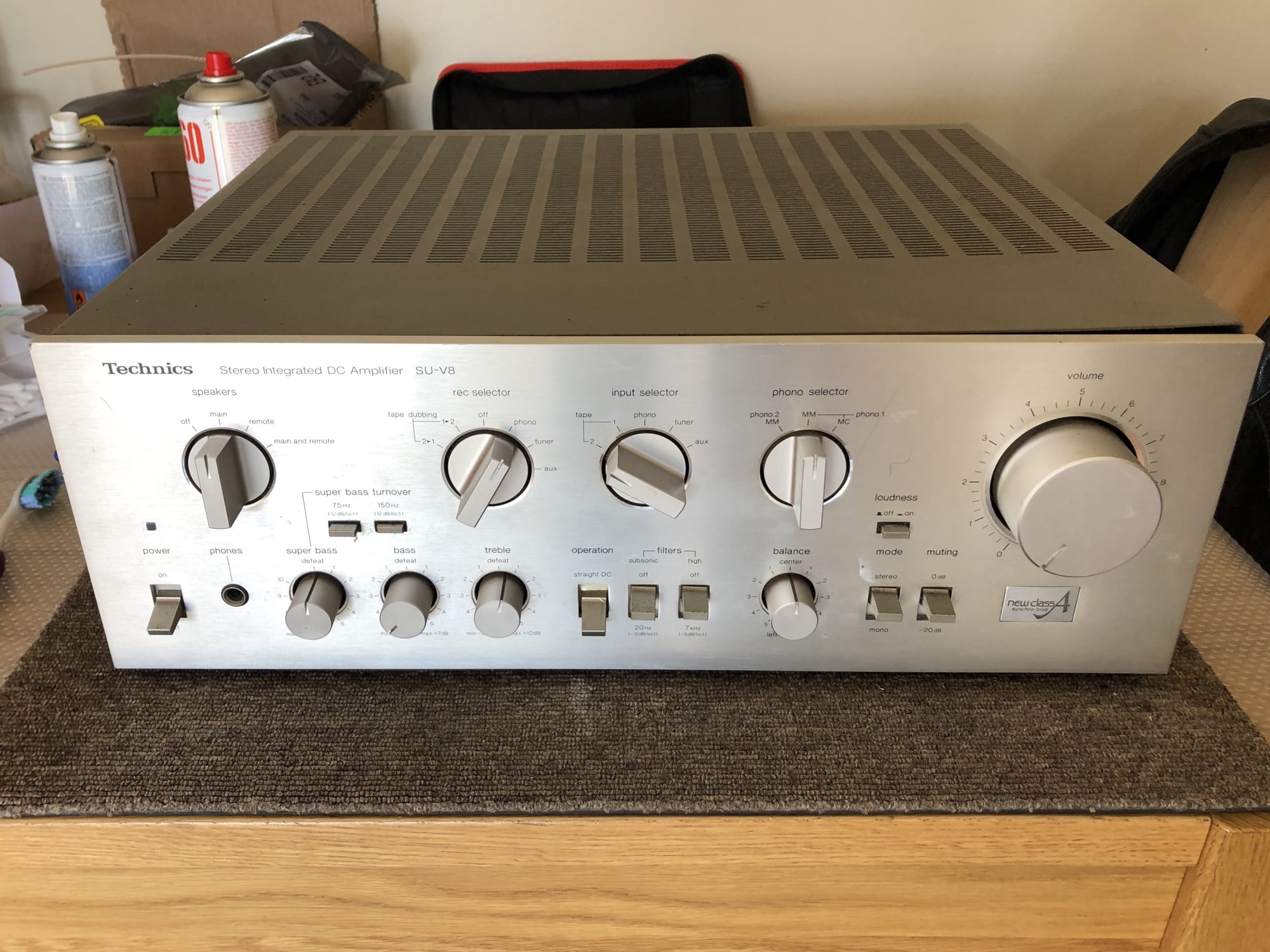
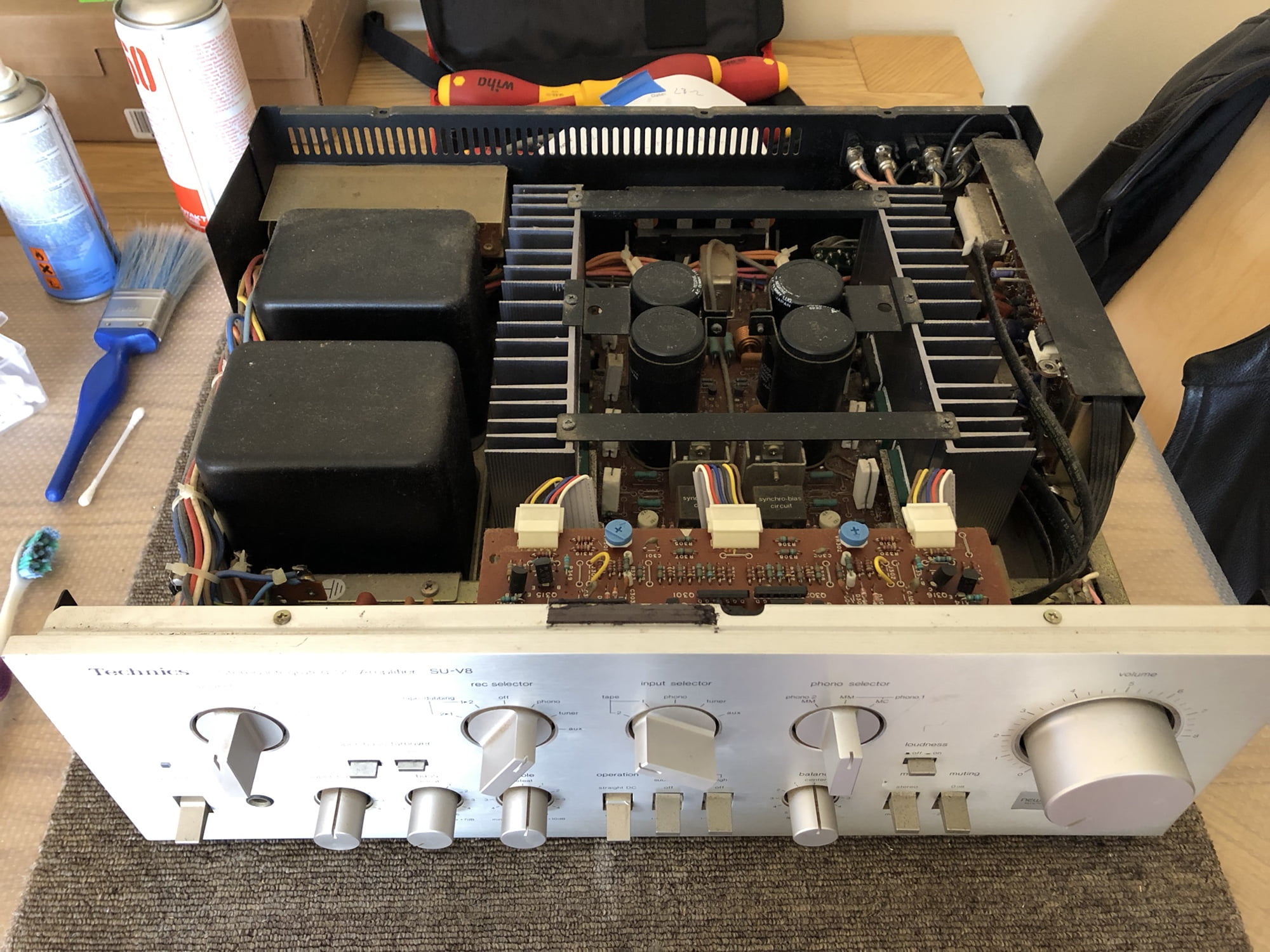
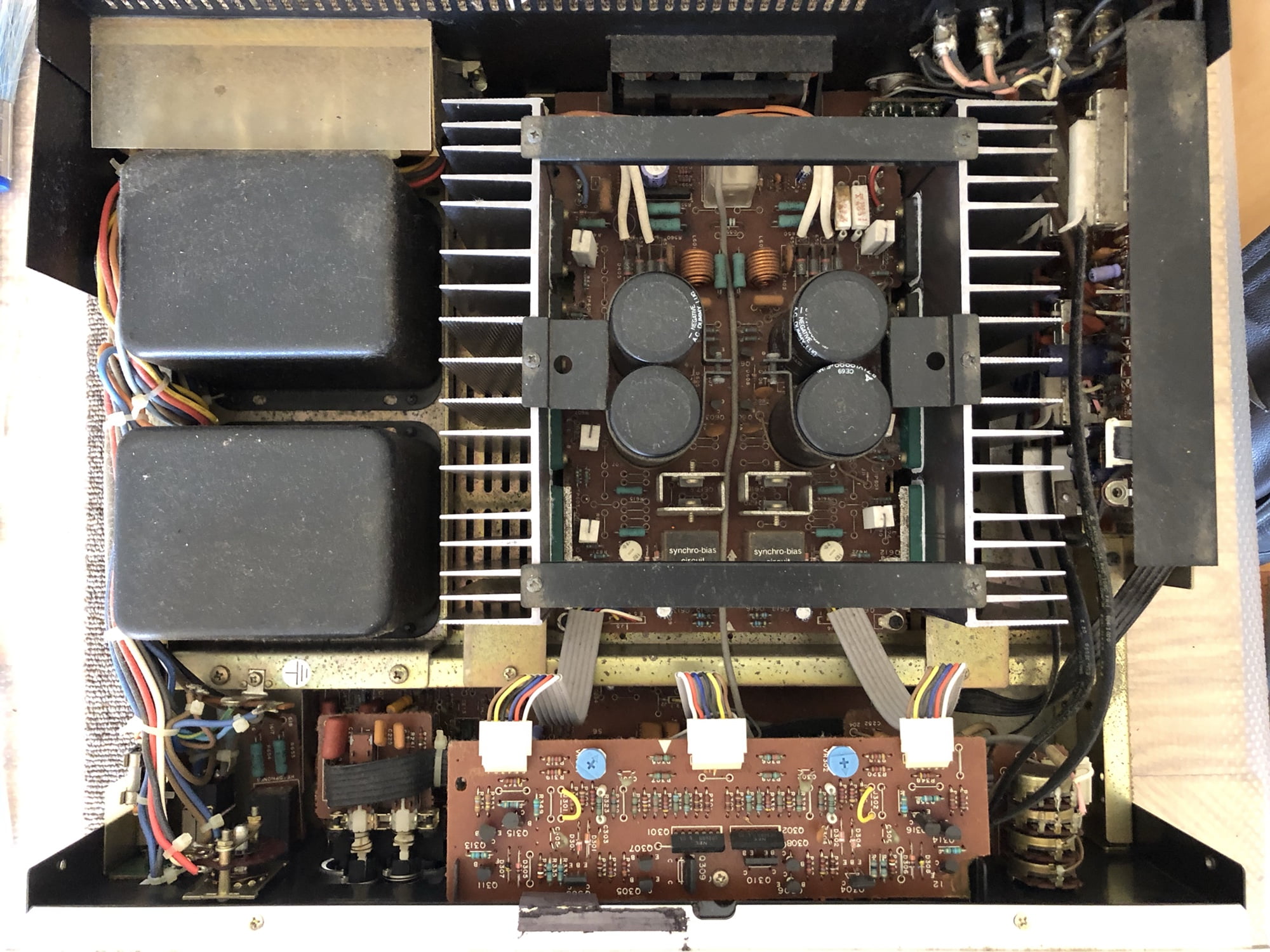
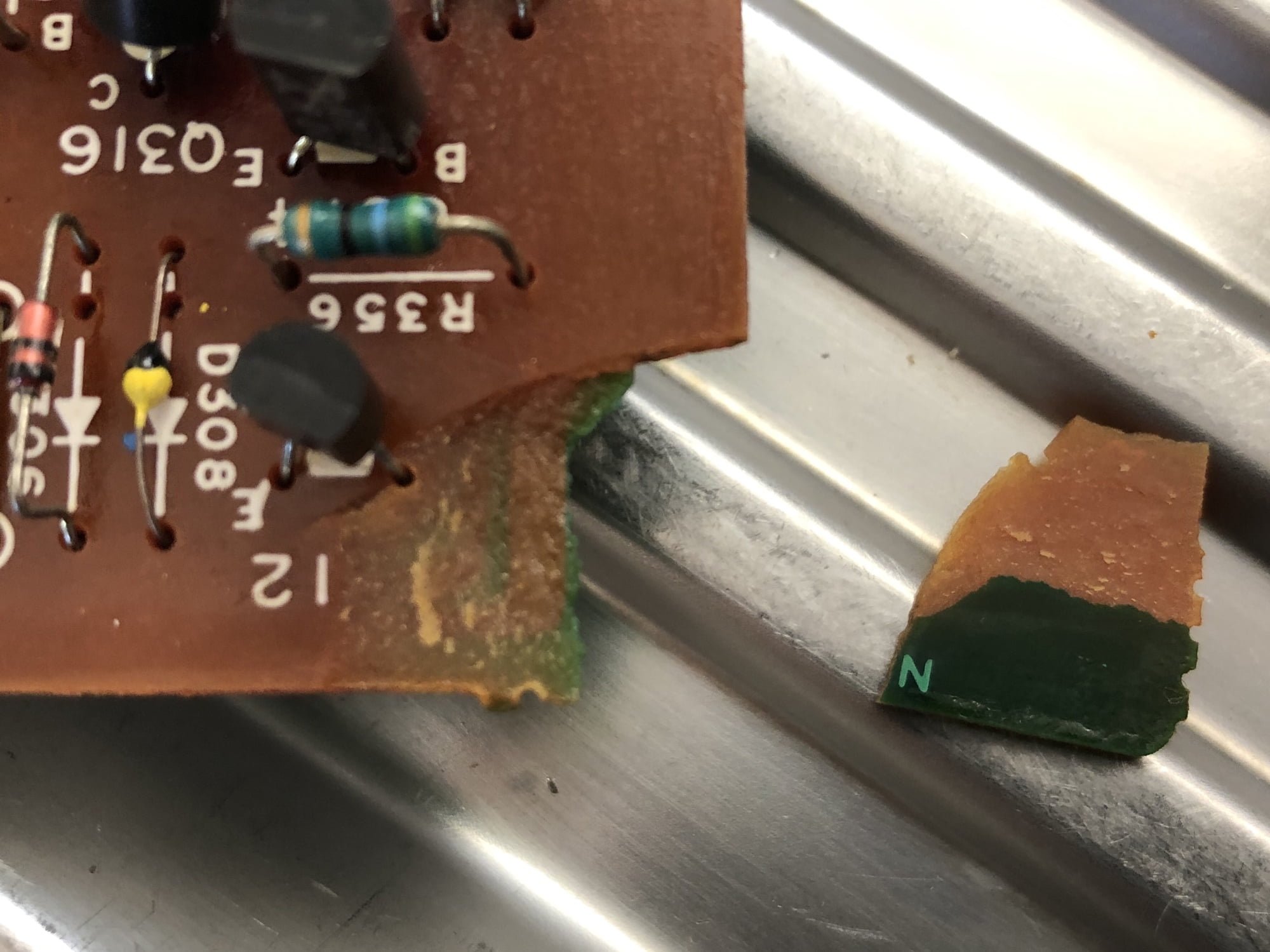
Cleaning
You can’t do anything much or even know what’s going on until you properly clean a very dirty piece of equipment like this. It’s always the starting point when servicing something like this, but it’s tedious. Unfortunately, there are no shortcuts.
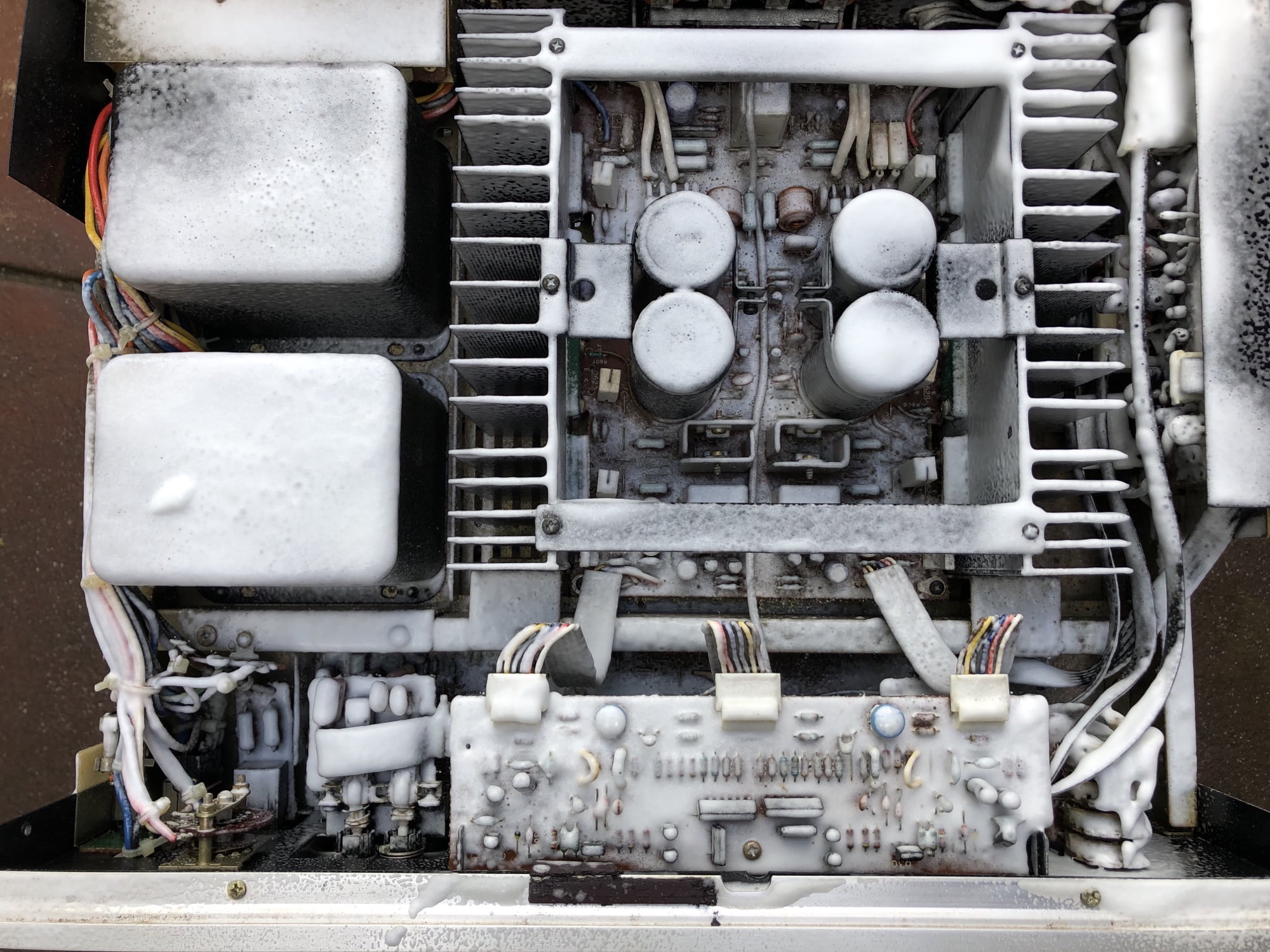
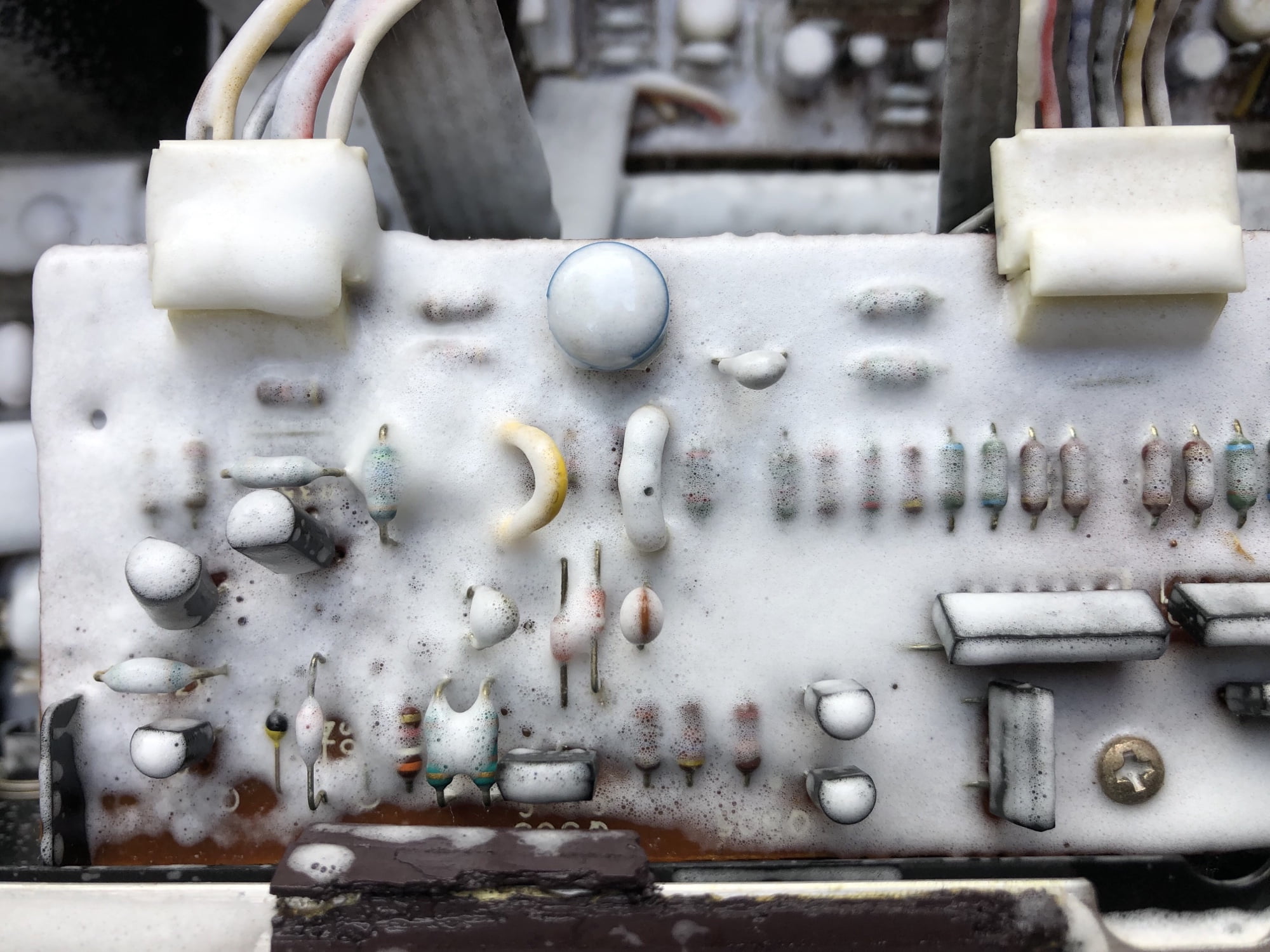
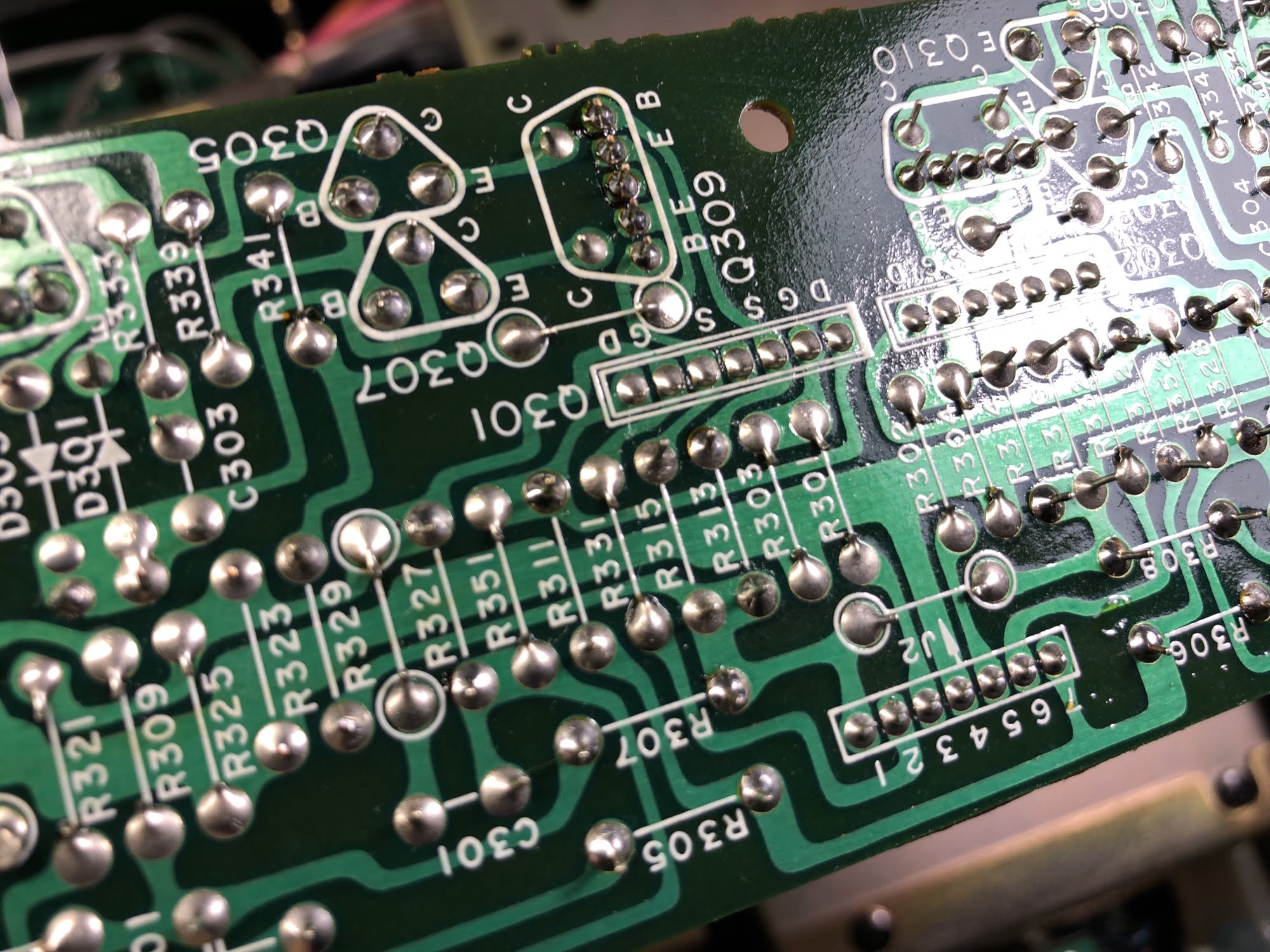
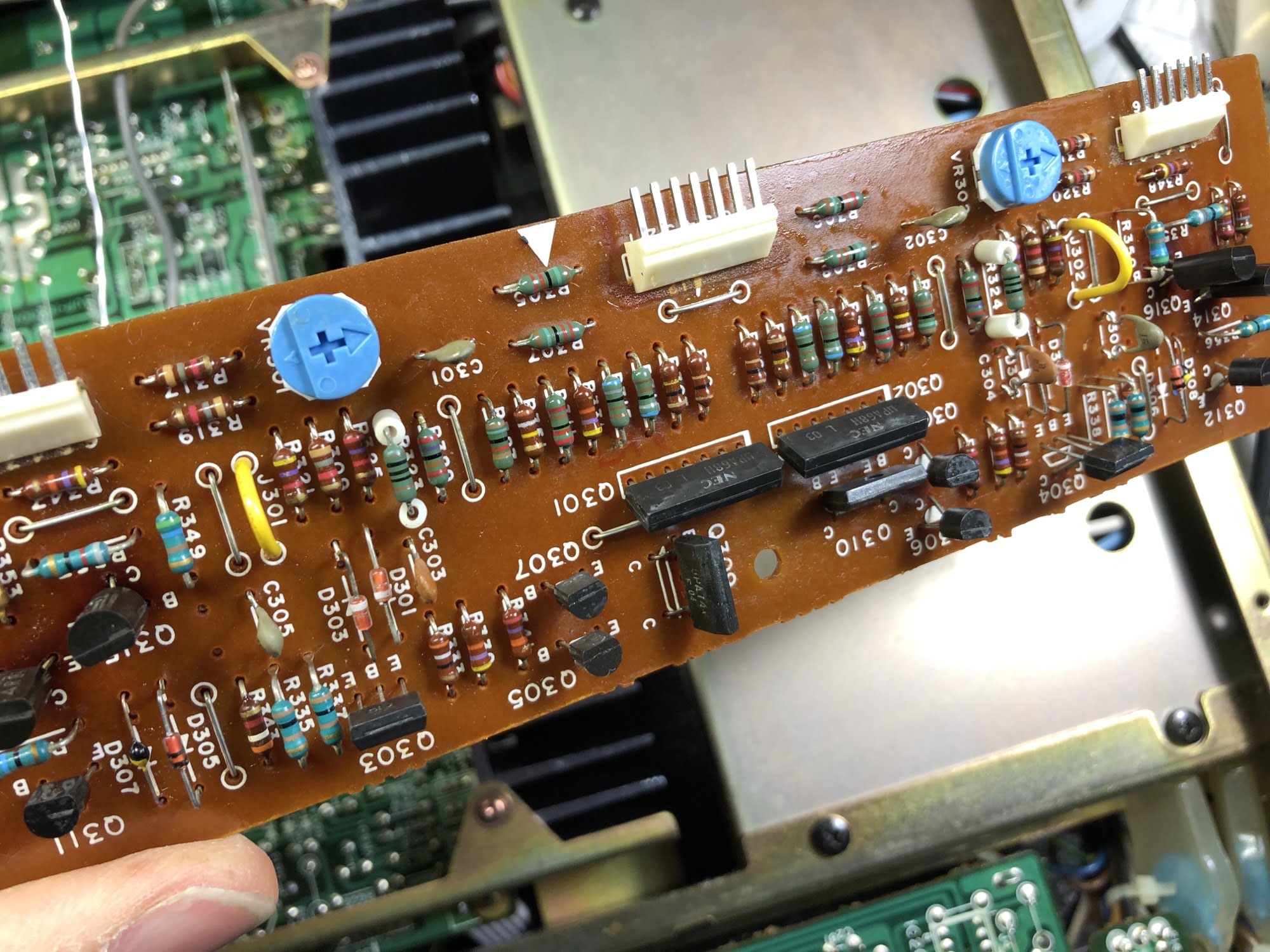
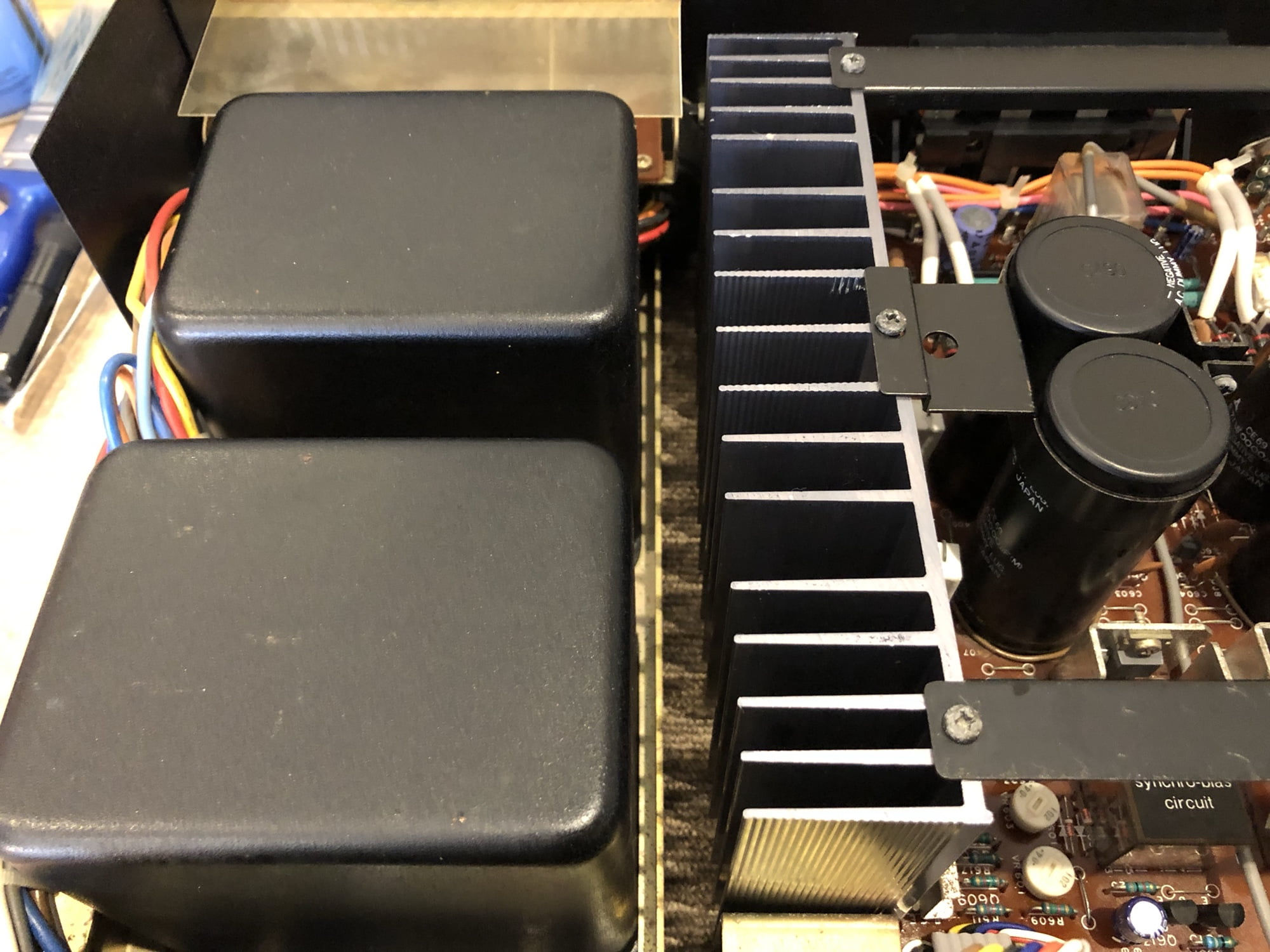
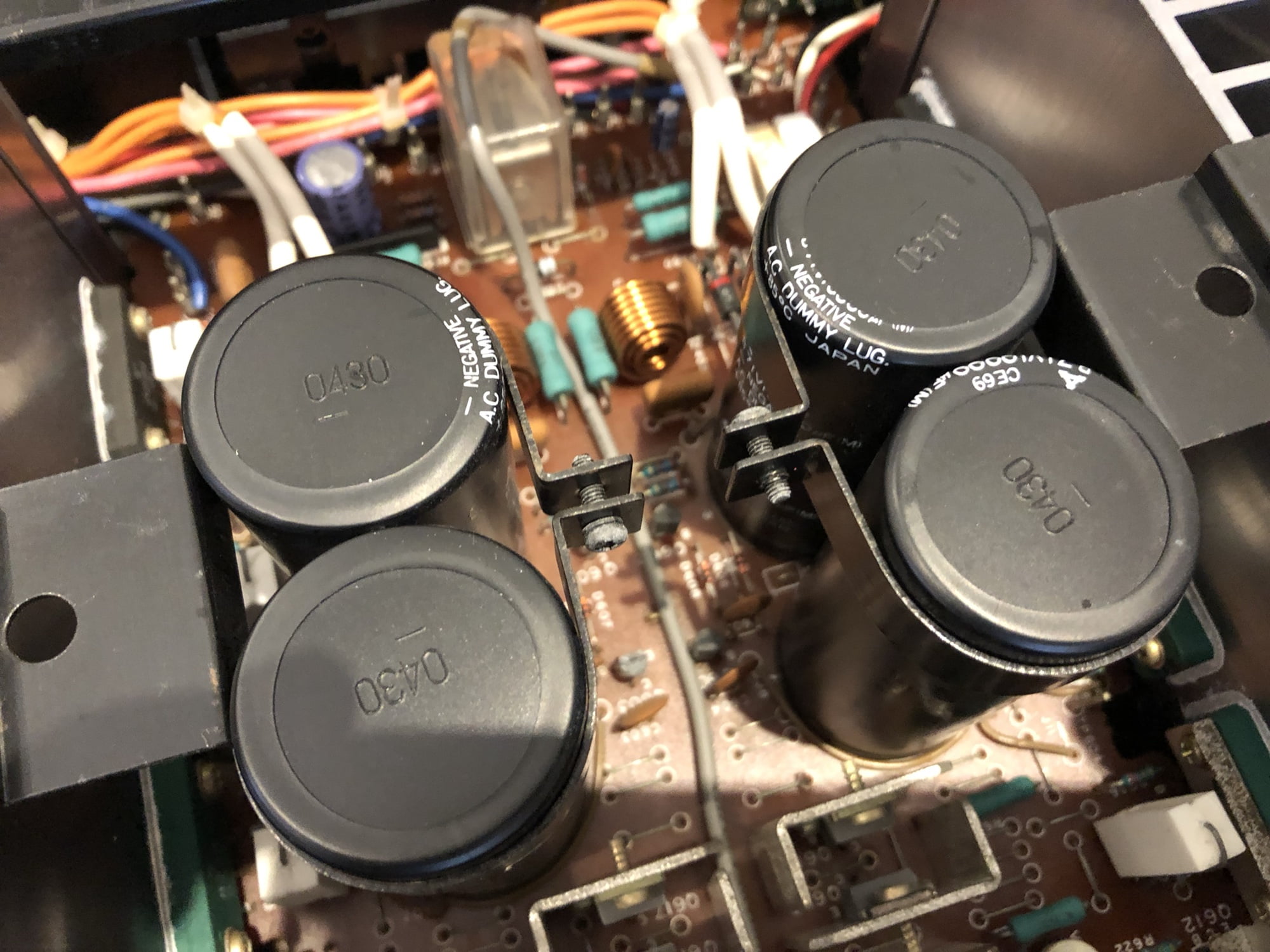
Repairs
Once I’ve cleaned and dried everything, reworked the boards as needed and thoroughly serviced the switches and controls, I generally start repairing things. In this case, the driver board needed fixing, as did the ‘New Class A’ logo lighting on the front panel.
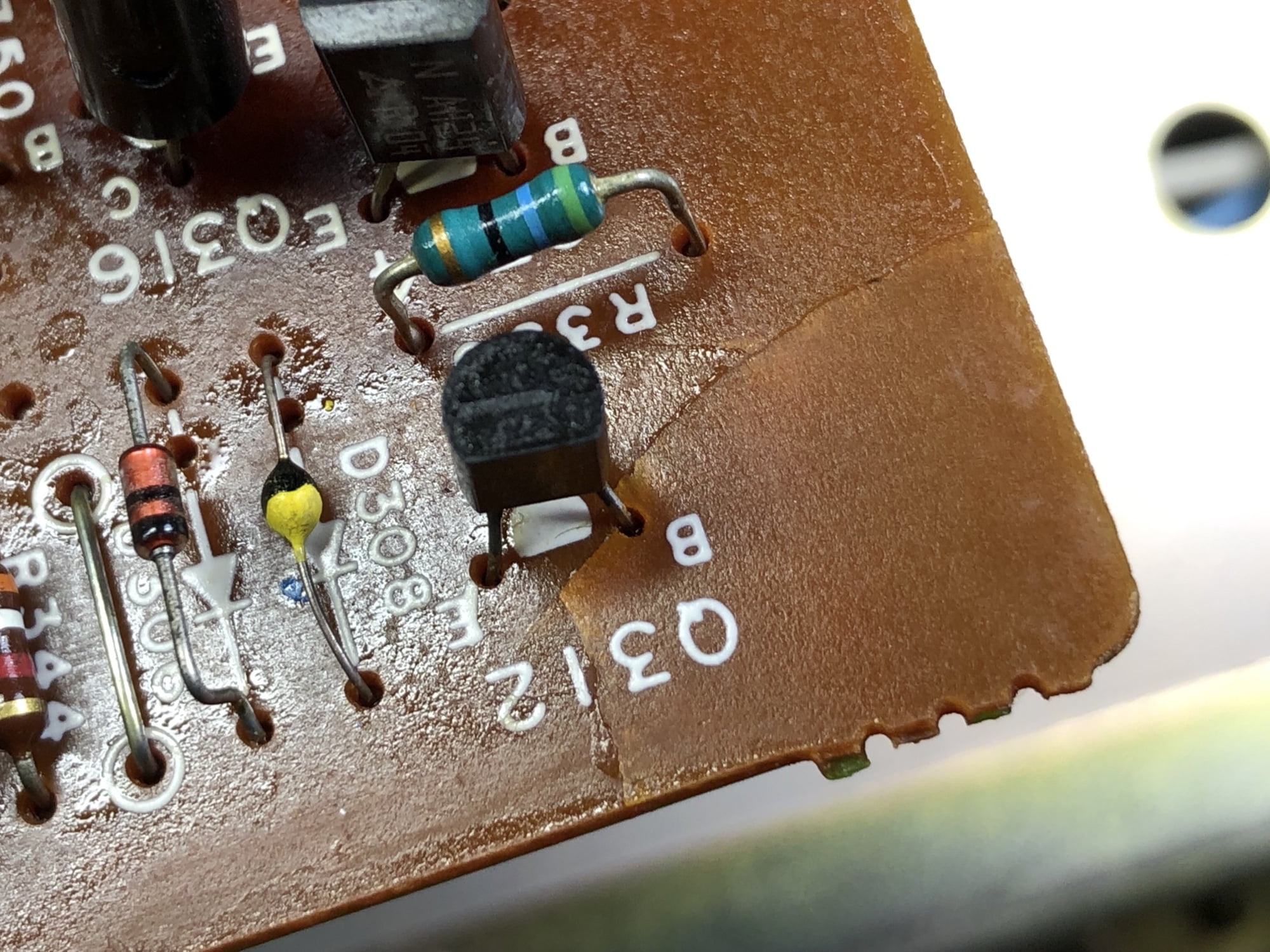
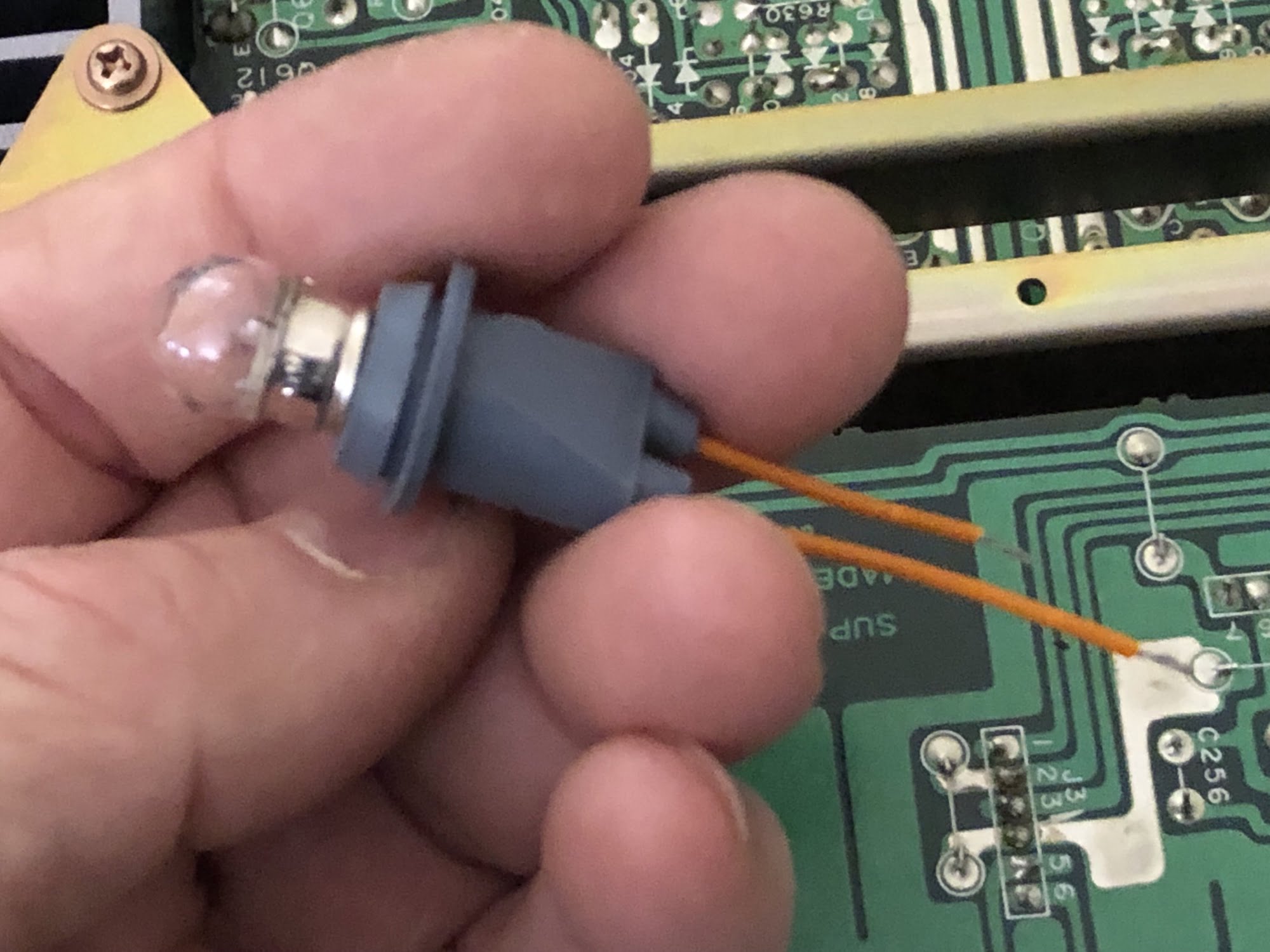
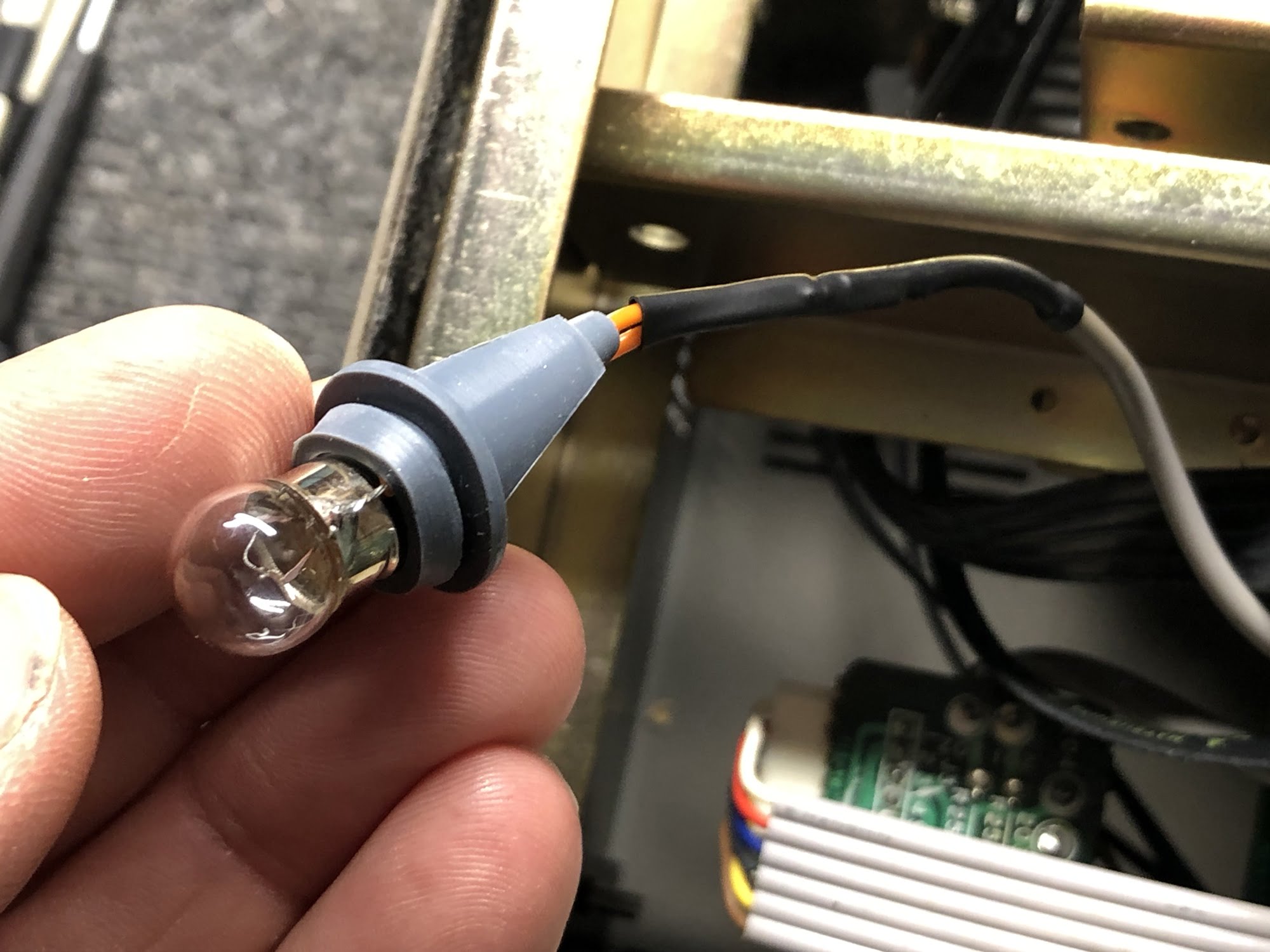
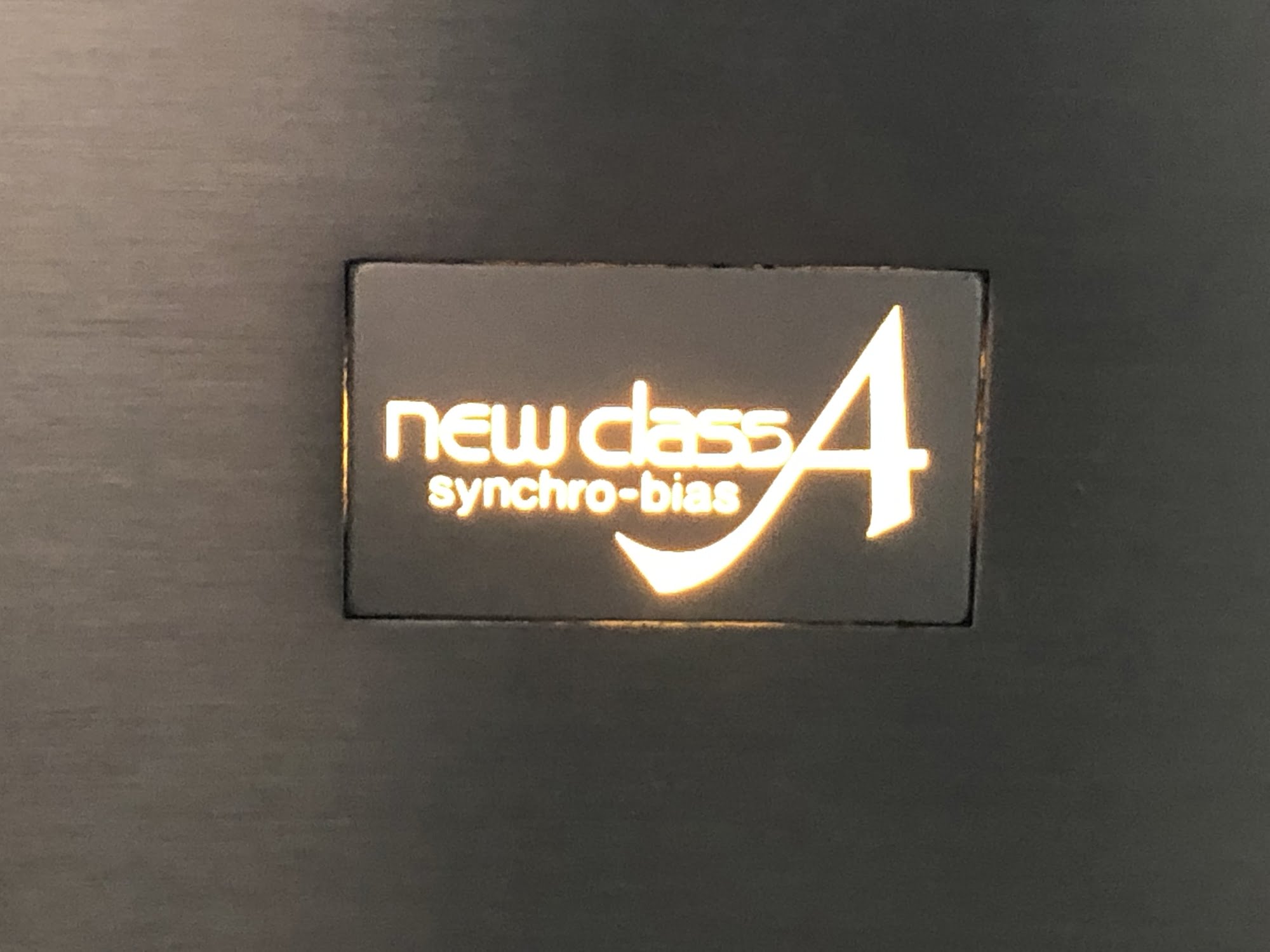
Testing & Adjustment
Once the repairs are done, it’s time to allow the amp to warm up, carefully test everything and then make all the adjustments, as per the service manual. For the Technics SU-V8, there are several adjustment steps needed.
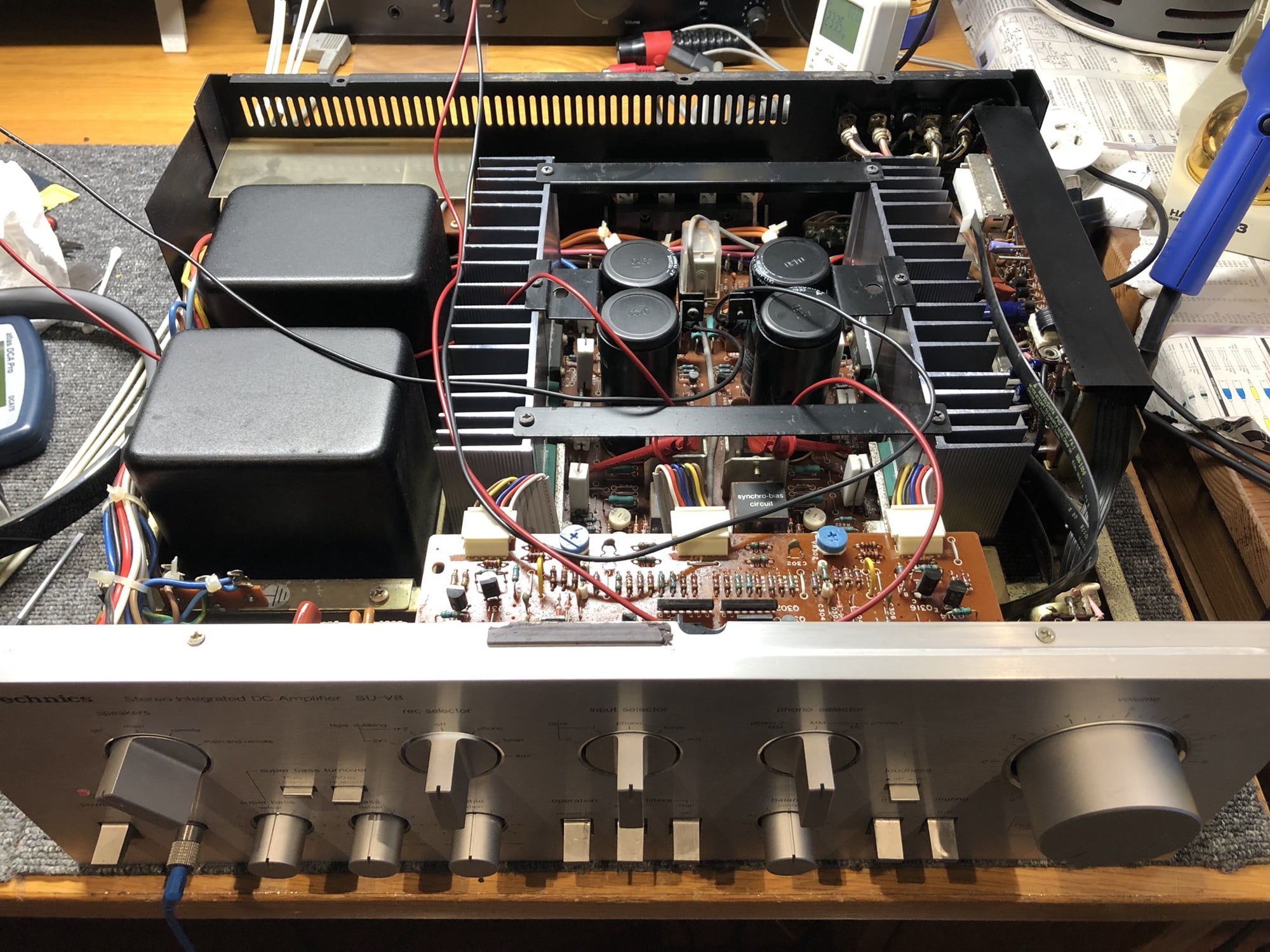
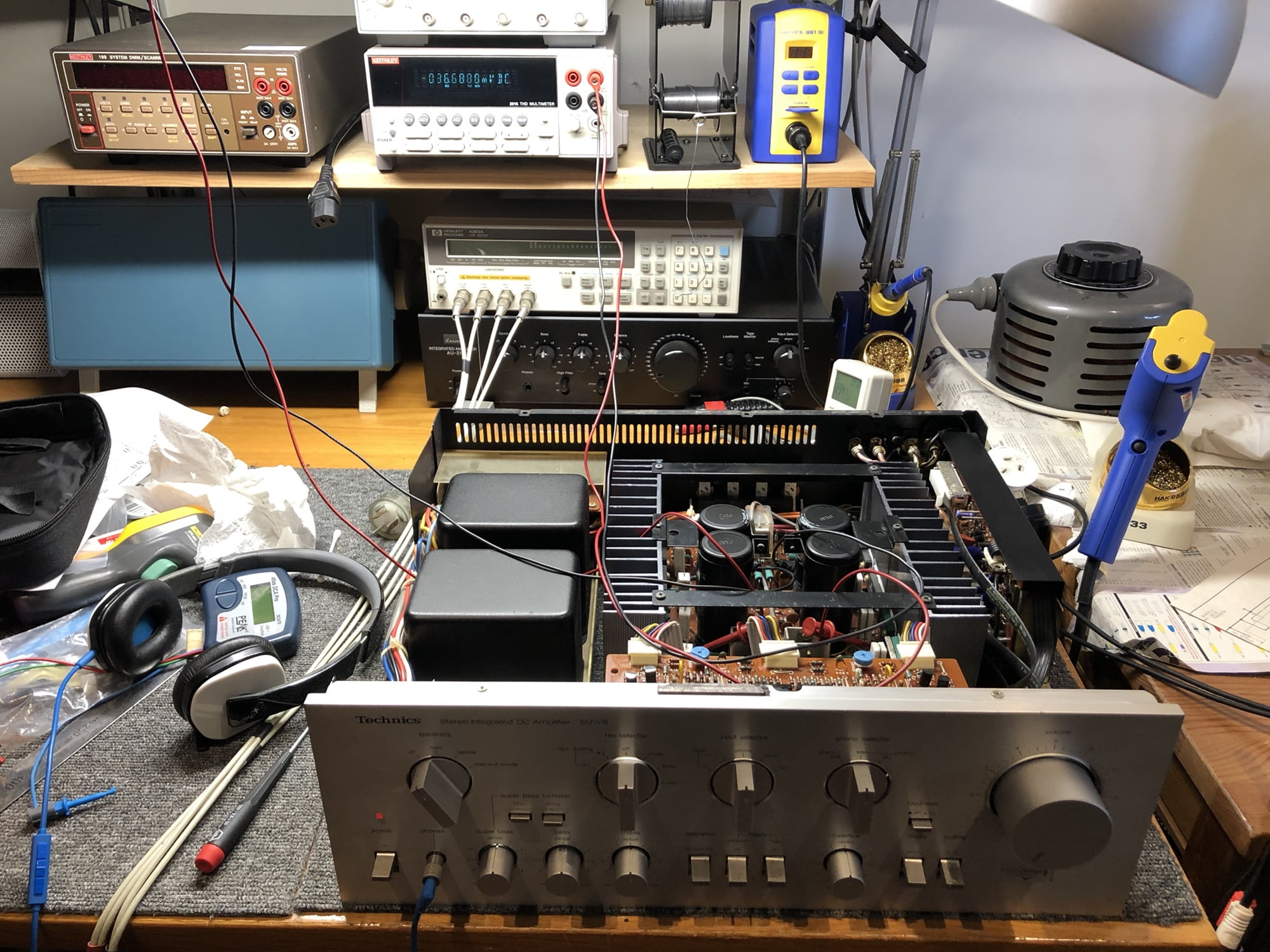
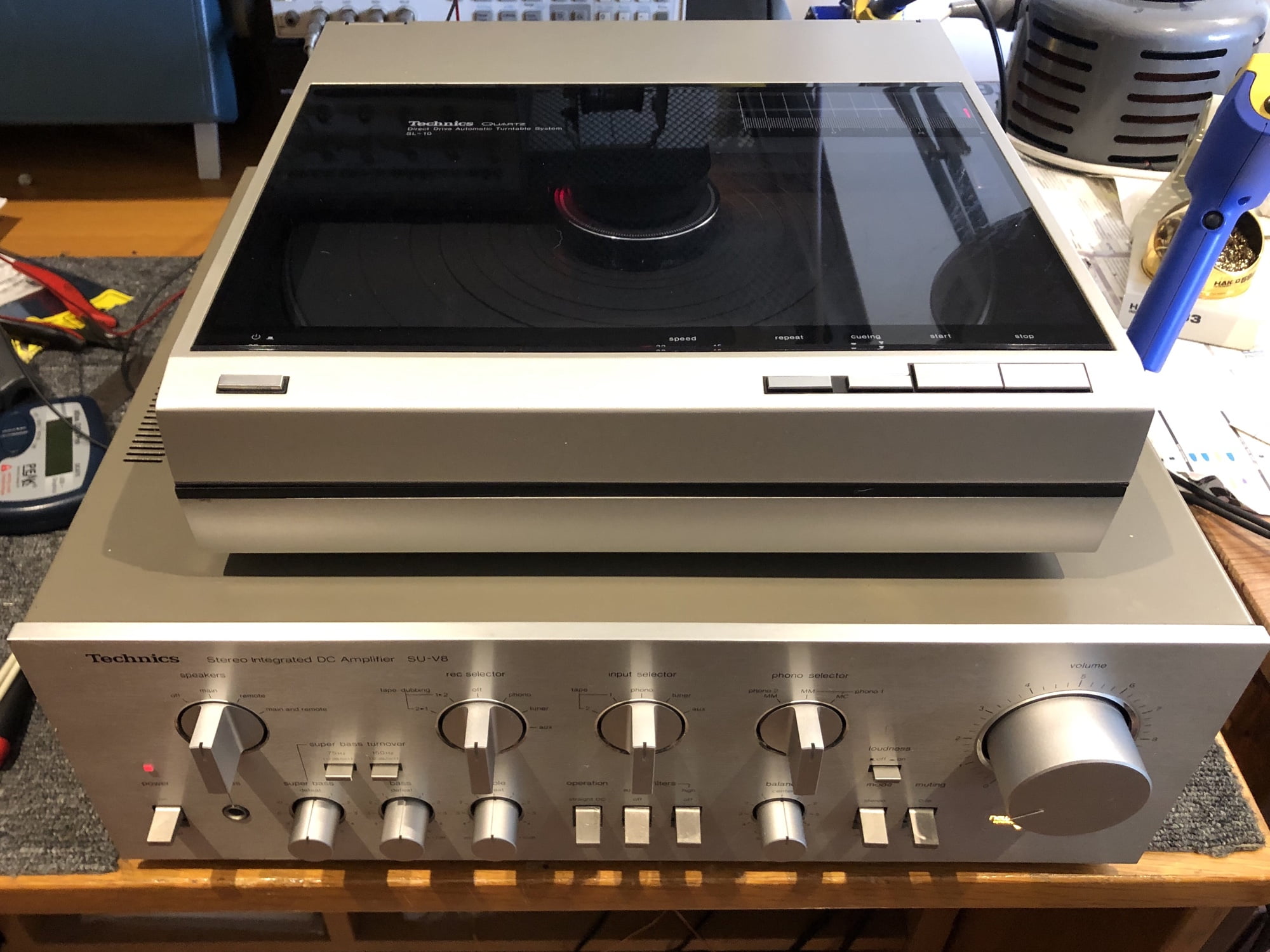
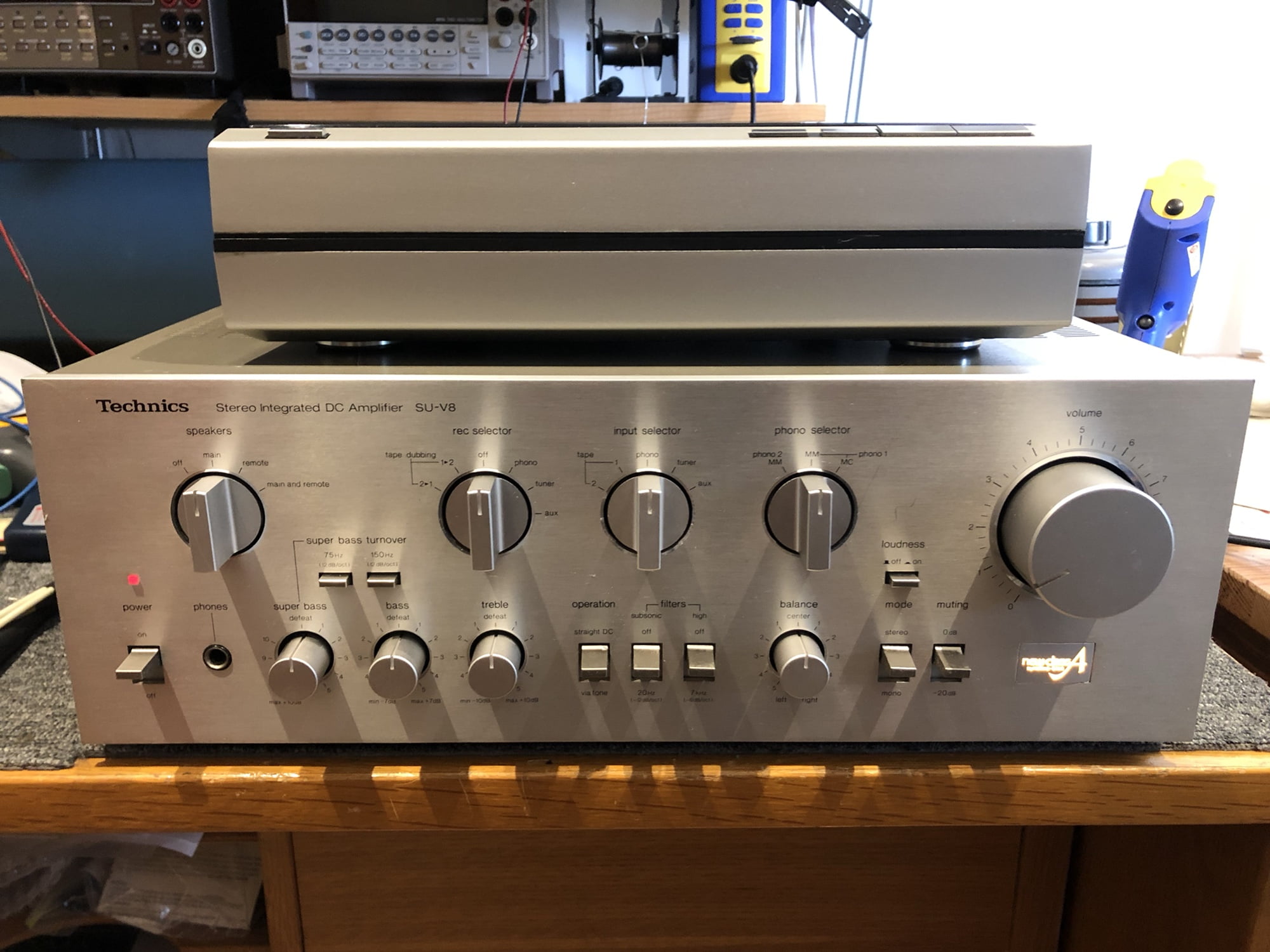
Results
I try to include quotes from owners when they get the gear back, so here’s what this lovely owner said when he plugged everything back in:
Wow, this sounds amazing!
This put a smile on my face and he’s right, it sounds fantastic, just look at the thing! My customer bought this amplifier for next to nothing because it barely worked. He spent some money having it properly cared for and now has a perfectly working example of an SU-V8, an iconic Japanese hi-fi amplifier. You’ve got to be happy with that.

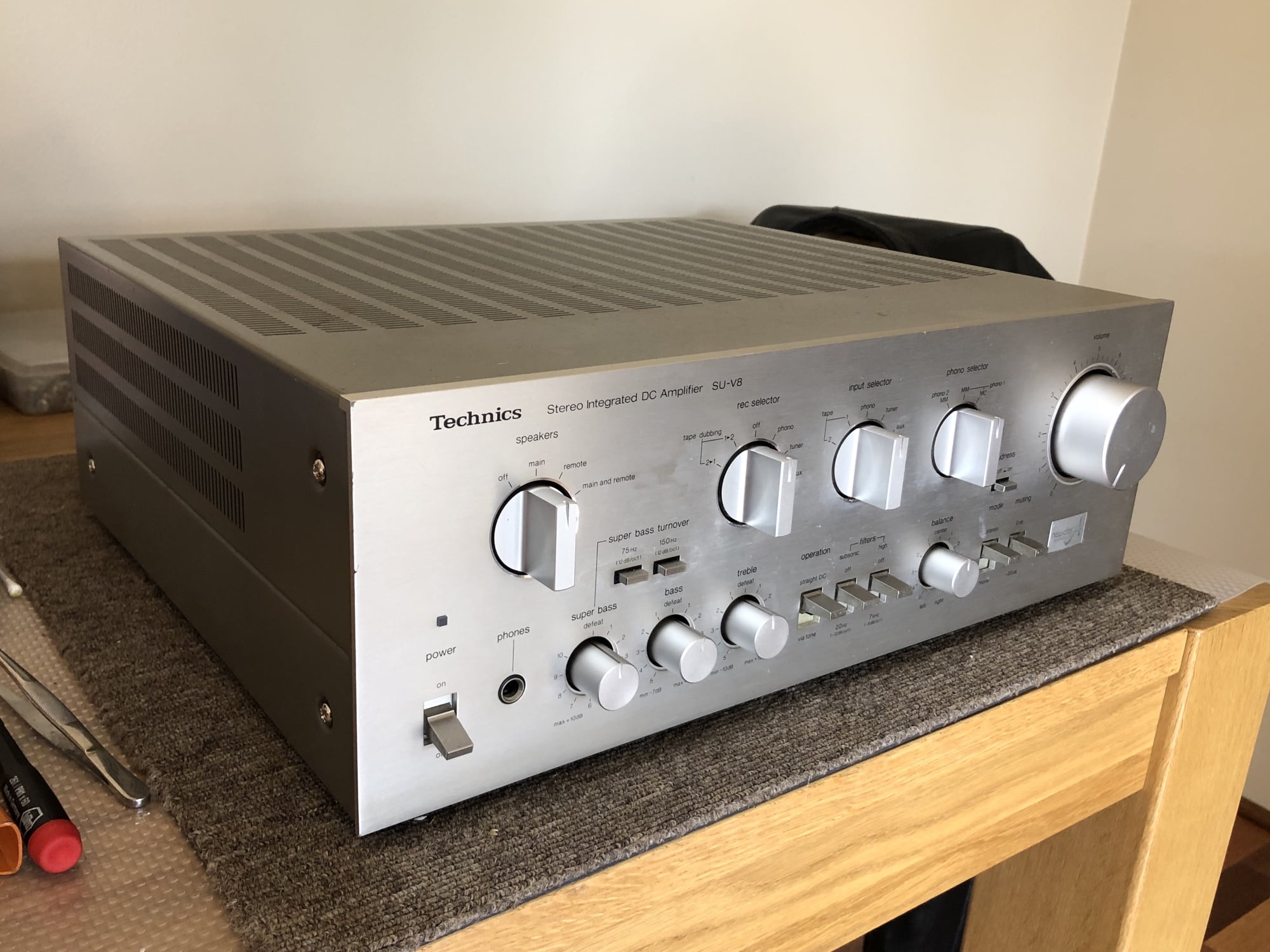
If you would like me to service, repair or restore your Technics SU-V8 or any other Technics amplifier, don’t hesitate to get in touch.
Discover more from LiQUiD AUDiO
Subscribe to get the latest posts sent to your email.

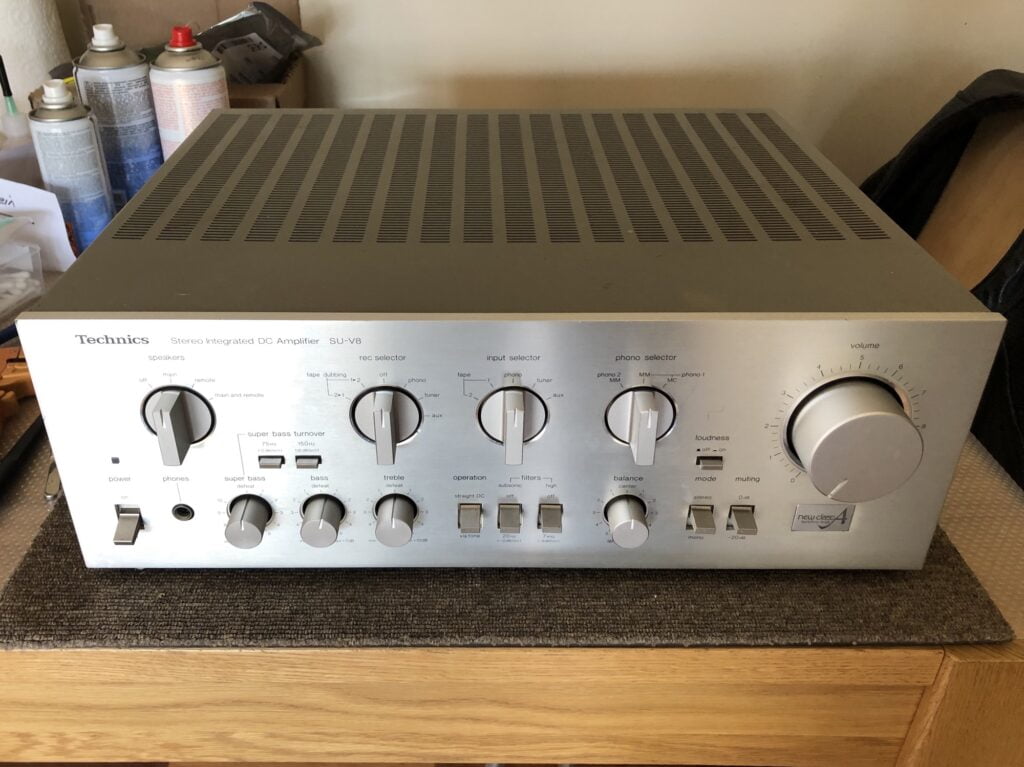
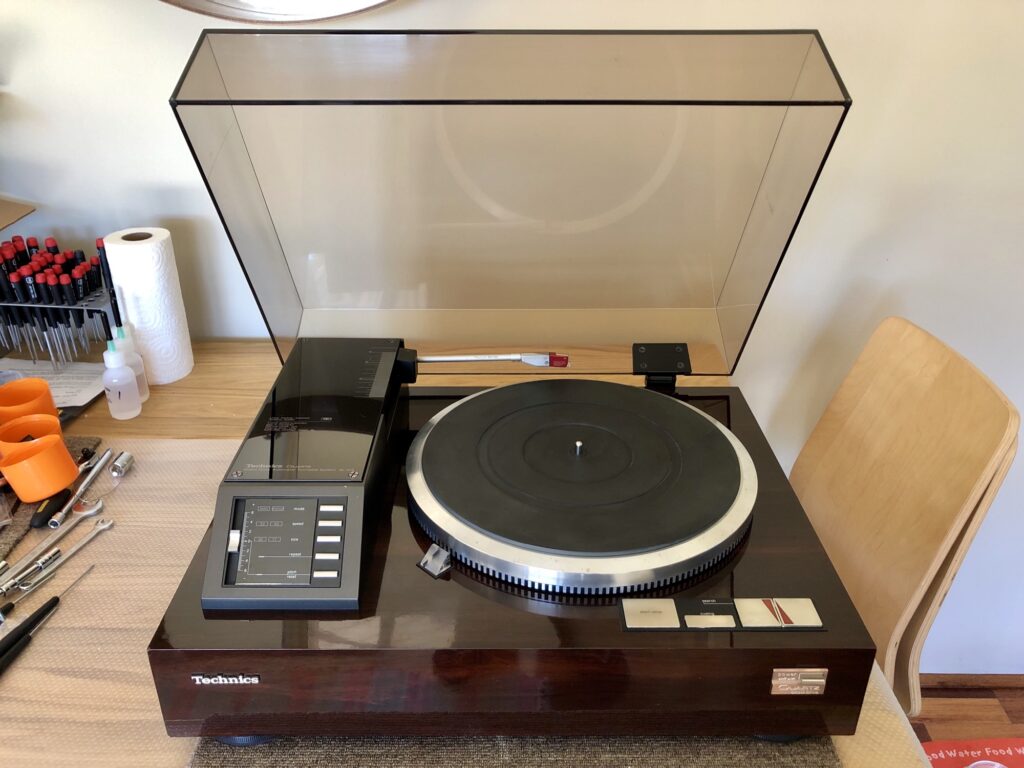
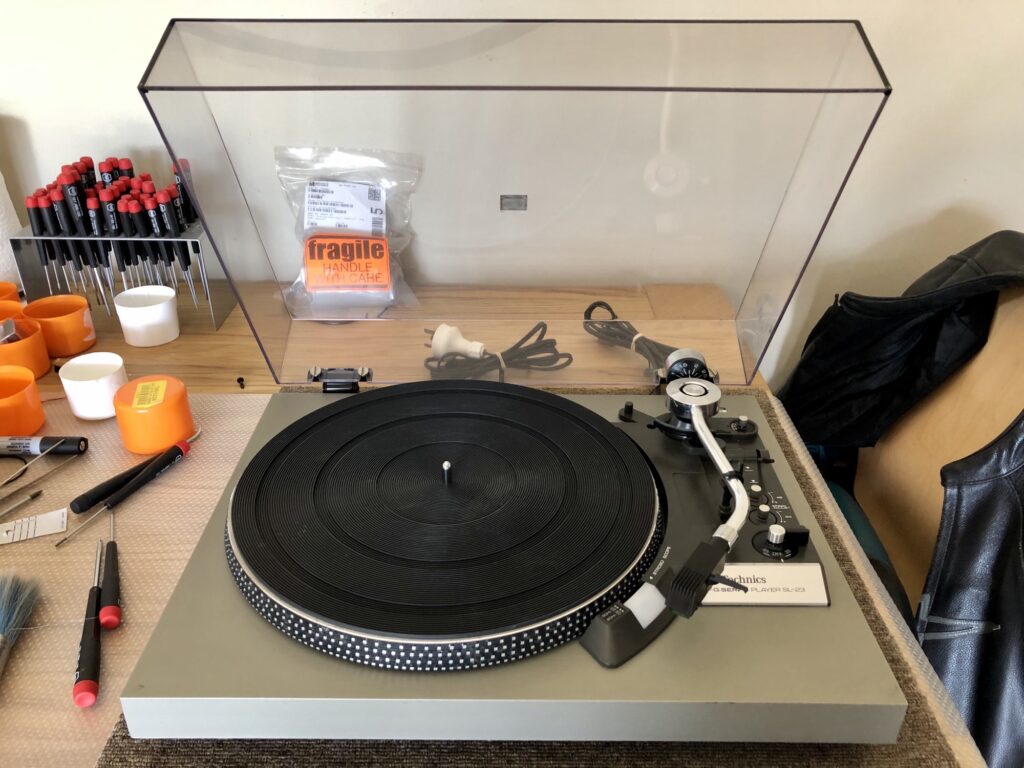
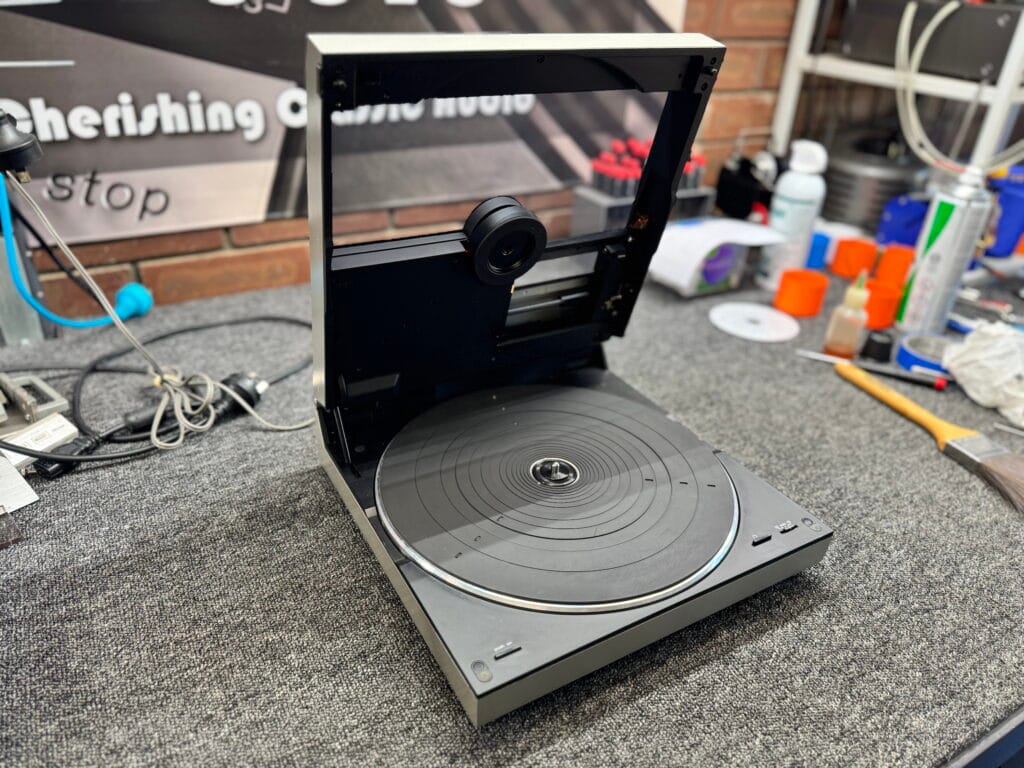
They are a great amplifers i have 2 , a black and silver, and would never part with them. Great to see them getting revived and brought back to spec
Hi Sam, you are very lucky to own two of these, thanks for your comment and glad you enjoyed the article!
Can you tell me what the foaming cleaner you used to wash the amplifier is called ?
Hi Jeremy, thanks for your question. I love helping my readers but I like keeping them alive as well! I don’t generally go into details about how I wash equipment for a number of reasons. There are technical considerations and the method varies according to the type of equipment, boards and dirt present. Most importantly though, it has the potential to kill you if you get it wrong. For these reasons, I strongly suggest not washing electronic equipment unless you have access to a temperature-controlled drying oven and really know what you are doing. I hope this makes some sense, let me know if you have any other questions.
Hi there is it recommended to fit a cooling fan to the SU-V8 amp
Hi Joe, it’s not necessary under normal usage conditions, ie adequate ventilation, amp sitting in free space, not in a cabinet, sensible speaker load etc. Generally, these things don’t run hot, if yours is, this indicates something else is not right.
Hi,
Congratulations on the excellent article, very useful.
I have a beautiful SU-V8 with a problem.
The input selector has broken and I can’t find any spare parts.
can you help me?
this is what i’m looking for:
https://i.postimg.cc/zvkP01Jp/IMG-20191010-170534.jpg
Thanks
Hi, thanks and glad you found the article useful. I don’t have a switch like that in stock but this system was widely used. I am sometimes able to find parts like this given time and where equipment comes to me for service or repair. I’d need the unit here for physical matching in terms of length, number of detent positions etc. Do you live locally? I don’t generally sell or ship service parts for reasons relating to time, cost and the aforementioned need for matching in this case.
Hi Crina
One of my V8s input selector cable broke also and i found one on ebay, but I was fortunate it was being parted out.
There is a Technics SU-V9, i got a new inputboard from the seller for my V9, It should fit a V8, ask the seller he may have it. Shipping is pretty steep for a small cable. He still may have the cable for the input selector
https://www.ebay.com.au/itm/264301163015
Hi Sam,
thank you very much for your help.
I write from Italy and it would be great if the cable was still available.
I did a search on Ebay but couldn’t find the SU-V9 cable! 🙁
Hello Crina,
Ask the seller, he may have it but its not listed. He still had the V9 input board when i asked him. With luck he may have it, Being in Italy the shipping will be less.
https://www.ebay.com.au/usr/hifi-teile?_trksid=p2047675.l2559
Greetings from Australia
Sam
And don’t forget folks that there are potentially other remote switch assemblies that will also work. The trick is finding and trying some. If there is a local SU-V9 being parted out though, that could be very useful.
I own a black one for almost 40 years. Fantastic amp. it just died half a week ago. No more sound, after a few minutes there comes a loud short buzz.
I’m sure it needs some TLC.
Shame your workshop could’t be further from where I live (Netherlands, the other side of this world)
Thanx for your vid, I definatly am going to have it repaired!
Hi Wilbert, thanks for your comment and I’m really glad you are going to get yours repaired. Definitely a good idea!
Dear Sir, thank you for your review. I stumbled over this amplifier by chance one year ago and was completely surprised by its sound and quality. Actually it took the place of my before Quad 33/ 303 combination with Spendor speakers… As I am not a real hifi nerd I have not an awfull experience of very many different amplifiers. I have now Broadmann VC 1 speakers. With these the SU- V8 ofcourse sounds even better. With these very good speakers- is it worth to upgrade the amplifier as well, like with a sudgen 21a, or is the SU- V8 in your opinion also capable to play in this league?
By the way- thanks also for your review of the Technics SL- 10 turntable. That was a fantastic hint! I bought one and with the Ortofon OMP 30 it sounds even better then with the Technics MCP 310…. Thats really high class for little money.
Hi Erik, thank you for your very welcome comments and feedback. I agree with you, the SU-V8 really is a lovely amplifier. I think though that you will find a class-A or good MOSFET or VFET amplifier will sound even better, this is certainly my experience. I’m glad you found an SL-10 and thanks also for letting people know about the OMP-30. These have a very good quality diamond and are great sounding MM cartridge.
Hi Mike,
Currently doing some minor check ups on my black SU-V8. She’s a little quite in on channel and volume fixes this, either dirty contacts, or solder joint or relay. I purchased before stock ran out of discontined at Mouser, but Digikey has it. Panasonic Relay for the V9. Not sure it would suit the V8 though. Part is Panasonic HC2-HP-DC24V-F
https://www.digikey.com.au/en/products/detail/panasonic-electric-works/HC2-HP-AC240V-F/3885784
Thanks Cheers Sam
p.s take care during the Corona19 that’s around the world atm
Hi Sam, thanks for commenting and for the relay part number. For those reading along at home, keep in mind that 9 times out of 10, relays can be very effectively serviced and do not need to be replaced. Very occasionally though, they will burn out or the contacts will fuse. In these cases, a new relay is a good way to proceed.
Hi mate, I was wondering what you thought of the su-v8x? I’ve found one for $250. From what I’ve read it’s a superior amp and has 120 watts per channel. Looks a lot different too.
Hi Jeremy, sounds like a great deal as long as it’s working well. I doubt it’s technically or mechanically superior though, due to its reduced weight and therefore cost savings in terms of construction. Still sounds like it’s well worth a look!
Hi Jeremy, I own a few Technics amps including the V8 and V8X. The V8X has a lovely sound, has more power say in 8ohm 120v – V8 is 105w into 8o ohm, but the V8 is 150w in 4ohm. I found the phono around the same for both amps, the V8X still has a decicated phono and is from 1984. V8X also has many more inputs cd aux 1 , 2 . Also dont have to worry as much for dirty connections that I found an issue now and then with the V8s and V9, i fixed that with a dust cover over the input and phono box. The V8X also has pre out and in, and my friend who has lots of Technics, and his fav amp is the v4x , and says the v8x is similar in sound, thats from someone that owns a lot of Technics amps
Dear Mike, thank for the video and article.
can you recommend me a cleaning foam or spray? I have the exact same amplifier from my dad and it has not been in use for 10 years or more, so I want to clean it good before i try it. Thanks for the help in advance. All the best.
Hi Sve, there are various foaming cleansers you can use for external chassis cleaning, plus other methods like a microfibre cloth and a mild, warm detergent solution. The foaming cleanser I use is a commercial product not readily available in retail outlets, but Servisol and 3M also make foaming cleansers, amongst others. Whatever you use, be sure to observe safety precautions and exercise particular care any time water is used near electronics.
Hi Liquid Mike. I own a black Technics SUV8 amp and thoroughly enjoyed your you tube article. I have a problem with the amp though – when I switch it on, it is supposed to have an audible click after a few seconds to indicate the amp is functioning, but sometimes I have to wait for half an hour before it “clicks”! What could be the cause of it? I’m in Cape Town South Africa and it’s winter here so it’s very cold at the moment. Could the temperature be the cause? Otherwise please advise where the problem could be.
Would appreciate your comments please.
Hi Colin, thanks for your question. There are many potential causes for the protection circuit taking a long time to activate, but the environmental temperature is not one of them. The amp should become active after only a few seconds, irrespective of environmental conditions. The protection circuit monitors safe operating conditions of the amplifier like DC symmetry, output device over-current, operating temperature and so on. My advice with anything like this is to take her to a specialist with hands-on experience repairing amplifiers like your lovely SU-V8. She will be very repairable in the right hands and at this age will no doubt need some TLC to bring her back to her best. Hopefully, you have someone local you can use.
Thanks for the prompt reply and advice – much appreciated
No problem at all, I only wish you lived closer so I could fix her for you!
After my old 50w amp died and you gave me some guidance, I turned up one of these SU-V8 amps and it woke up my speakers like you said a better amp would.
I am over the moon with it, especially now I paired it with a decent vintage CD player.
It does need a service so I am watching the contact page keenly waiting for a vacancy in the workshop.
Thanks for the honest advice on where I best spend my money.
Fantastic news Anthony, I’m so pleased you’ve found a better amplifier and what a lovely amp these are! I look forward to looking at these for you, giving the amplifier a birthday is especially important and will make a night and day difference.